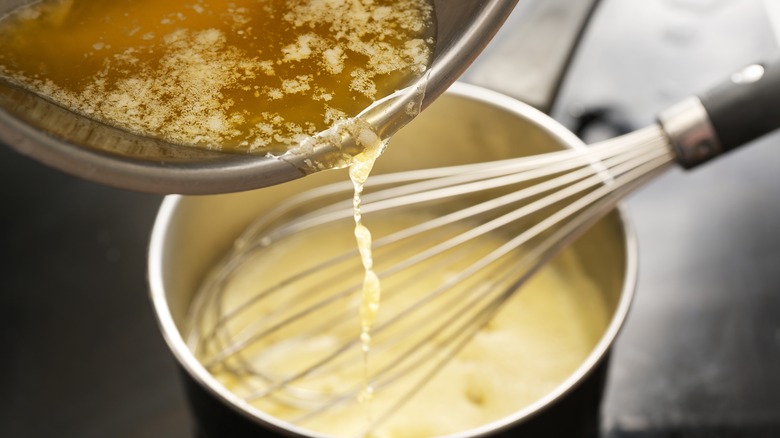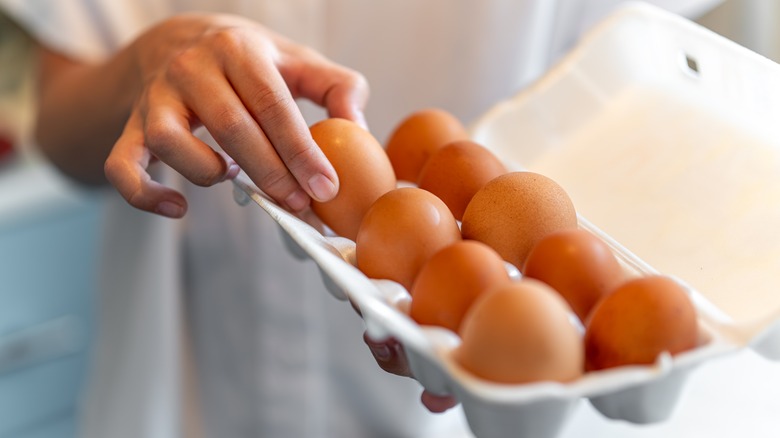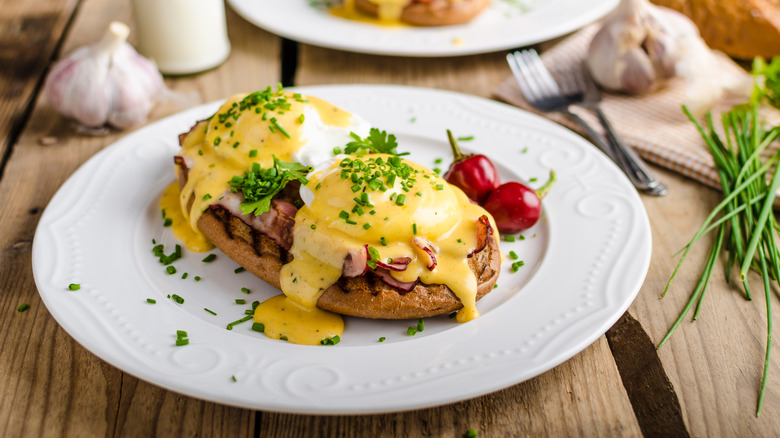Seriously, Stop Tempering Your Eggs The Wrong Way
Whether you're baking or cooking, one ingredient you've undoubtedly used repeatedly is eggs. Particularly in baking, eggs make the world go round. They add structure, moisture, and volume to your favorite muffins, cookies, and cakes. If you've been cooking for a little longer, you'll eventually come across a recipe such as crème brûlée, flan, or hollandaise sauce, which calls for egg tempering. Tempering is the process of heating or cooling an ingredient to get it to the temperature you need, in this case, slowly adding hot liquids to uncooked eggs without curdling or scrambling them. Once the eggs are warmed, they can be added to the remaining liquid mixture to achieve a smooth consistency.
If you're not familiar with tempering eggs, there are some mistakes you want to avoid so that your flan really does turn out like a silky traditional flan and not a scrambled egg disaster. Not bringing your eggs to room temperature, leaving your eggs unbeaten, adding too much hot liquid to your eggs, or not having the proper kitchen utensils are all things to avoid in the egg tempering rule book.
Room temperature eggs are crucial for tempering
Whenever a recipe calls for tempered eggs, it's important for you to first bring the eggs down to room temperature, as this will minimize your risk of scrambling the eggs and make the tempering process quicker. If you're reading this a little too late, you may need a quick method to get eggs to room temperature.
Once your eggs are at room temperature, you also want to lightly whisk the eggs in a bowl before adding any hot liquids. The trick here is not to over-whisk them. Once you see a little foam on your egg mixture, your eggs are ready. They might curdle later if you whisk them too much at this stage.
When it comes time to add the hot liquid to your eggs, add small (no more than ½ cup) amounts of liquid to your eggs while simultaneously whisking. If your egg mixture is still not warm, you can go ahead and add another ½ cup to your mixture. Don't be tempted to add more liquid at one time because, you guessed it, you'll end up with scrambled eggs.
Having the correct kitchen utensils — in this case, a whisk — is vital for perfectly tempered eggs. Vigorous whisking is necessary in this process, and without a whisk, achieving the smooth texture you're after will be difficult. A fork can substitute if you don't have a whisk (or regretfully lent yours out).
How to correct tempered eggs gone wrong
You may be reading this after the egg-tempering disaster has already struck. If that's the case, don't despair; your egg mixture might still be salvageable.
If your egg mixture has curdled (the eggs may have been too cold), place the mixing bowl in another bowl/saucepan of hot tap water for a few minutes. This will warm the ingredients, and you can whisk the mixture again until it emulsifies. If your curdled egg mixture is for a cake batter recipe, add 1 tablespoon of flour to the mixture and whisk just until the batter comes back together. Avoid overmixing, as this will activate the gluten and create a tougher cake.
Your tempered egg mixture may just be a little lumpy. In this case, pouring it through a sieve might help. If this doesn't do the trick, try blending your mixture in a blender on a high setting, just long enough to smooth out the mixture.
You might want to consider starting over if you've completely scrambled your eggs or if one of these methods doesn't give you the desired outcome. Not to worry, though. After reading this, you'll be equipped to temper eggs like a pro and make the best three-way crème brûlée or hollandaise sauce for a classic Eggs Benedict recipe.


